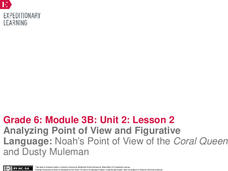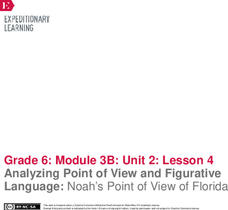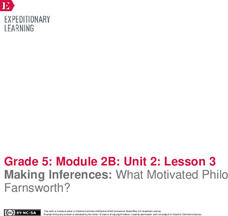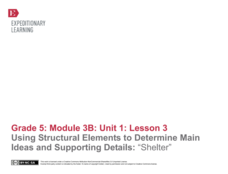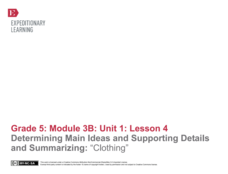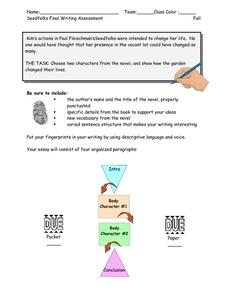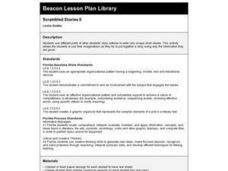EngageNY
Analyzing Point of View and Figurative Language: Noah’s Point of View of the Coral Queen and Dusty Muleman
Literally, what's the meaning? Scholars read pages seven through nine of Flush and discuss literal and nonliteral meaning with figurative language. Learners work in triads to identify and define unfamiliar words. They then complete a...
EngageNY
Analyzing Point of View and Figurative Language: Noah’s Point of View of Florida
Fishing for words. Scholars search for unfamiliar words in pages 27-29 of Flush, place them in their word catchers, and complete part of Noah’s Point of View graphic organizer. After identifying figurative language, learners analyze...
EngageNY
Carl Hiaasen’s Perspective of Florida: Part 3
What is your perspective? Scholars read Florida: A Paradise of Scandals Excerpt 2 and look for unfamiliar words. They determine author perspective by completing Gathering Evidence of Hiaasen’s
Perspective: Part three graphic organizer...
EngageNY
Carl Hiaasen’s Perspective of Florida: Part 2
Look it up. Scholars read Florida: A Paradise of Scandals Excerpt 1 and use a dictionary to look up any unfamiliar words. They then do a close read of the text and answer text-dependent questions. Learners analyze author perspective by...
EngageNY
Making Inferences: What Motivated Philo Farnsworth?
Turn on the tube. Learners take a look at pages 10-13 of The Boy Who Invented TV. They work in groups and complete a first read to determine the gist of the section. They then reread the pages to make and revise previous...
EngageNY
Using Structural Elements to Determine Main Ideas and Supporting Details: “Shelter”
Does the picture tell the story? Learners continue their work in The Inuit Thought of It by creating a visual gist of pages 16 and 17. They then complete a main idea graphic organizer and discuss key supporting details.
EngageNY
Determining Main Ideas and Supporting Details and Summarizing: “Clothing”
Surviving winter. Pupils begin reading on page 18 of The Inuit Thought of It: Amazing Arctic Inventions and sketch how the people used animal skin clothing to survive the winter. Readers complete a main idea graphic organizer...
EngageNY
Relationships Between Key Scientific Concepts: What Causes Hurricanes?
A storm is brewing in the sea. Scholars complete multiple reads of How Does a Hurricane Form to determine gist, cause-and-effect relationships, and deepen vocabulary understanding. To finish, they complete graphic organizers...
Livaudais-Baker English Classroom
Literacy Analysis for Lord of the Flies
Here's an assignment sheet that models for readers how to craft a literary analysis of William Golding's Lord of the Flies. The packet includes a graphic organizer, a model outline, a model essay, and a detailed rubric.
Curated OER
Frindle: A Guiding Reading Unit
Guide your class through a reading of the popular children's book, Frindle, with this comprehensive literature unit. Starting with a brief introduction to the guided reading process, the class goes on to read the story two chapters...
Do2Learn
Processing Cause and Effect
Examine one cause and its effect in-depth. To complete this graphic organizer, learners write down a topic, the cause, the effect, and a brief analysis of the cause and effect relationship.
Curriculum Corner
Informational Text Graphic Organizers
Scholars delve into an informational text with the help of four pages that focus on the author's purpose, vocabulary words, summarization, and main idea.
Curriculum Corner
Fiction Graphic Organizers
Accompany fictional reading with a instructional activity that compares a story's characters, setting, and theme.
Curriculum Corner
Informational Text Graphic Organizers
Accompany informational text reading—independent or whole class—with a worksheet that challenges scholars to examine the text's main idea, details, take notes, and record vocabulary words and their meanings.
Curated OER
A Graphic Scene
Third graders discuss the advantages of using various graphic organizers including Venn Diagrams and T-charts. They use the organizers to compare and contrast different versions of classic mythological stories.
Curated OER
Graphic Organizers
In this literacy worksheet, students use the created resources for further progress towards knowledge. The sheet is a teacher's guide for creating student resources.
Curated OER
Graphic Organizer: Story Pyramid
In this graphic organizer: story pyramid worksheet, students analyze 6 components of the story (exposition, conflict, rising action, climax, falling action, resolution) and write the details in the boxes.
Curated OER
Story Pyramid
In this pyramid graphic organizer worksheet,learners use the story organizer to sequence the events in a story. Students describe the five parts of the story.
Curated OER
Venn Diagram for Compare/Contrast
Use this lesson to focus on a compare and contrast writing structure in your middle school language arts class. Here, young writers compare and contrast two texts using graphic organizers. They use a double bubble format for their...
Curated OER
Seedfolks Final Writing Assessment
Wrap up a study of Seedfolks with a final essay. Writers can draft their essays by following the steps and filling in the organizer provided here. The packet begins with a prompt, includes a few basic requirements, and provides an...
Bright Hub Education
How to Outline, Plan & Write a Memoir
Get to know each individual through a memoir project. The lesson outlined here is a bit vague, but has some promising ideas for graphic organizers to help writers prepare their work. In order to succeed with the lesson, you will need to...
Polk Bros Foundation
Topic Report Learning Organizer
If you'd like to quickly access a simple graphic organizer designed for a class to divide and conquer a larger subject, then check out this resource. Assign class members to study a specific topic within a historical theme or event, and...
Curated OER
Scrambled Stories II
Review story elements with your class. They will use examples from a story to develop critical-thinking questions. Then they use a graphic organizer to describe the setting, character, and plot of the story, focusing on how they...
Curated OER
Analyzing Two or More Nonfiction Texts
How does recognizing the author's purpose help you draw conclusions about a topic? Using two articles (both are attached), learners brainstorm why each author wrote each article. Are their purposes similar or different? Learners use a...
Other popular searches
- Main Idea Graphic Organizers
- Science Graphic Organizers
- Math Graphic Organizers
- Sample Graphic Organizers
- Writing Graphic Organizers
- Graphic Organizers for Math
- Math and Graphic Organizers
- Using Graphic Organizers
- Graphic Organizers Rating=3
- Graphic Organizers for Reading
- Pre Writing Graphic Organizers
- Vocabulary Graphic Organizers


